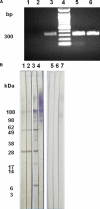Molecular characterization of the North American lung fluke Paragonimus kellicotti in Missouri and its development in Mongolian gerbils
- PMID: 21633042
- PMCID: PMC3110363
- DOI: 10.4269/ajtmh.2011.11-0027
Molecular characterization of the North American lung fluke Paragonimus kellicotti in Missouri and its development in Mongolian gerbils
Abstract
Human paragonimiasis is an emerging disease in Missouri. To characterize local parasites, we examined crayfish from three rivers. Metacercaeriae consistent with Paragonimus kellicotti were detected in 69%, 67%, and 37% of crayfish from the Big Piney, Huzzah, and Black Rivers, respectively. Sequencing of the second internal transcribed spacer and other DNA markers confirmed the species identification and the presence of identical parasite sequences in clinical specimens from two human cases. Mongolian gerbils were infected by intraperitoneal injection with 3-8 metacercariae. Most gerbils died 15-49 days post-infection. Necropsies showed pulmonary hemorrhage with necrosis, and flukes as long as 8 mm were recovered from intrathoracic tissues. Western blot analysis using P. kellicotti antigen showed a strong antibody response in gerbils 39 days post-infection. These results demonstrate that P. kellicotti is common in Missouri crayfish. The gerbil model may be useful for research on the pathogenesis, immunology, and treatment of paragonimiasis.
Figures



References
-
- World Health Organization Comtrol of foodborne trematode infections. Report of a WHO study group. World Health Organ Tech Rep Ser Infect Dis. 1995;849:1–e157. - PubMed
-
- Lane MA, Barsanti MC, Santos CA, Yeung M, Lubner SJ, Weil GJ. Human paragonimiasis in North America following ingestion of raw crayfish. Clin Infect Dis. 2009;49:e55–e61. - PubMed
-
- Centers for Disease Control and Prevention Human paragonimiasis after eating raw or undercooked crayfish—Missouri, July 2006–September 2010. MMWR Morb Mortal Wkly Rep. 2010;59:1573–41576. - PubMed
-
- Ameel DJ. Paragonimus, its life history and distribution in North America and its taxonomy (Trematoda: Troglotrematidae) Am J Hyg. 1934;19:279–317.
Publication types
MeSH terms
Substances
LinkOut - more resources
Full Text Sources

